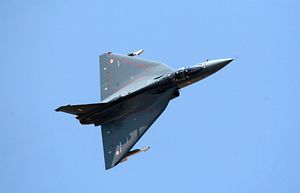The Indian Air Force (IAF) has issued a tender to India’s state-owned Hindustan Aeronautics Limited (HAL) on December 20 for the procurement of 83 Tejas Light Combat Aircraft, India’s first domestically designed and produced light fighter aircraft.
“HAL has received Request for Proposal (RFP) for 83 LCAs from Indian Air Force,” HAL said in a brief December 20 statement.
According to HAL officials who spoke to IHS Jane’s Defense Weekly, the RFP includes orders for 73 single-engine LCA Mark-IA fighter jets and 10 tandem two-seat LCA trainer aircraft.
The Tejas LCA is a supersonic, single-seat, single-engine multirole light fighter aircraft that has been under development since 1983 by the Aeronautical Development Agency in cooperation with HAL.
The LCA Mark-IA vis an improved version of the original Mark-I variant found to have various technical deficiencies including inadequate electronic warfare capabilities, problems with the onboard radar system, and reduced internal-fuel capacity.
The upgraded Mark-IA LCA will be fitted with an advanced active electronically scanned array (AESA) radar system, a new electronic warfare sensor suite including a self-protection jammer, and a new externally refueling capability.
The newer variant will purportedly also have less maintenance requirements, which have been repeatedly criticized by the IAF. As I reported in November, the IAF issued a report highlighting other deficiencies in comparison to foreign fighter jets:
According to IAF assessments, the Tejas LCA, when compared to Saab’s JAS-39 Gripen and Lockheed Martin’s F-16, boasts reduced airborne endurance — 59 minutes versus three hours for the Gripen and nearly four hours for the F-16. The Tejas can also only carry a weapons payload of around three tons against nearly six tons by the Gripen and seven tons by the F-16.
Furthermore, maintenance requirements for the Tejas LCA are also higher than with foreign combat aircraft. The Tejas LCA requires 20 hours of serving for every hour of flying against six hours for the Gripen and 3.5 hours for the F-16. In addition, the service life of the Tejas LCA is also half that of the 40 years found in both the Gripen and F-16.
HAL is struggling to keep up with the production of first-generation Tejas LCA of which the IAF has ordered 40, as I noted previously:
HAL has not been able to meet the target of producing eight Tejas aircraft per year. In July 2016, the IAF inducted the first two serially-produced LCAs, followed by two more aircraft in the same year. Twelve more aircraft are currently at the production stage. The Indian government has also been pushing HAL to ramp up production capacity from eight to 16 aircraft per year.
In a December 2017 note to the Indian Parliament cited by Business Insider, the Indian Ministry of Defense (MoD) states: “Out of total 20 IOC [initial operational configuration] aircraft (16 fighters and four trainers), five fighters have been delivered by HAL to IAF till date. The production of remaining 15 IOC [initial operational configuration] aircraft (11 fighters + four trainers) are taken up at HAL. (…) Production for 20 FOC aircraft, will be taken up after FOC clearance by Aeronautical Development Agency (ADA).”
The Indian Air Force plans to induct a total of 123 Tejas Mark-IA aircraft, next to 40 first-generation Mark-Is. In November 2016, the Indian MoD approved the purchase of 83 Mark-IA Tejas. The first 40 aircraft ate scheduled for delivery to the IAF by the end of 2018 — a date that likely will be pushed back. Production of the Tejas Mark-IA aircraft is expected to kick off in 2019. The maiden flight of a Tejas Mark-IA is slated to take place next year.
































